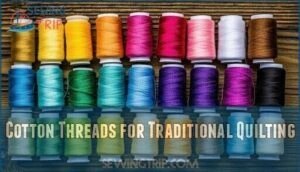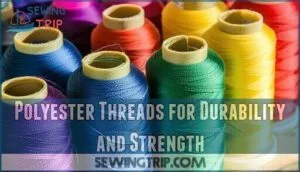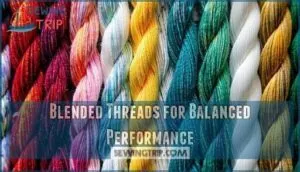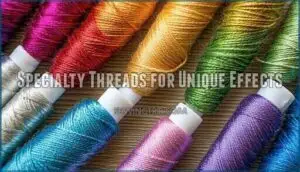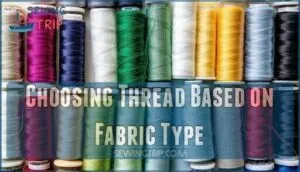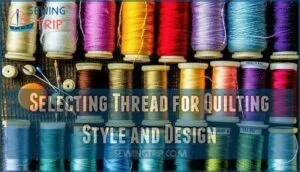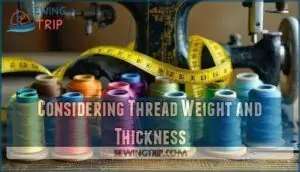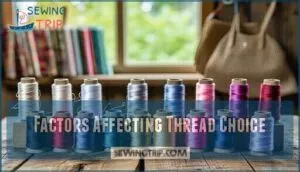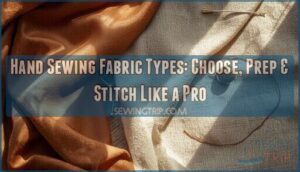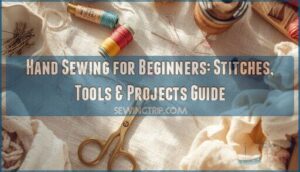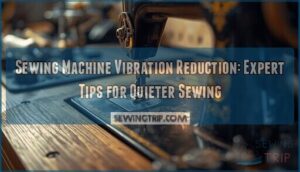This site is supported by our readers. We may earn a commission, at no cost to you, if you purchase through links.
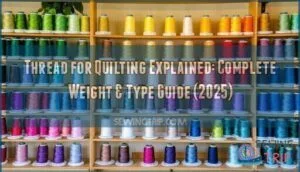 Understanding thread for quilting explained starts with weight—the lower the number, the heavier the thread.
Understanding thread for quilting explained starts with weight—the lower the number, the heavier the thread.
Cotton thread works best for piecing quilt blocks since it’ll shrink with your fabric, while polyester excels at quilting because it’s stronger and won’t shrink.
Most quilters stick with 40-50 weight thread for everyday projects, though 30 weight creates bolder lines and 60 weight disappears into delicate work.
Thread type matters as much as weight—cotton gives that classic look, polyester offers durability, and specialty threads add unique textures.
The secret lies in matching your thread choice to your fabric and quilting goals.
Table Of Contents
Key Takeaways
- Thread weight numbers work backwards – you’ll get thicker, more visible stitching with lower numbers like 30-weight, while higher numbers like 50-weight create finer, less noticeable lines
- Match your thread type to your fabric and goals – cotton thread shrinks with your fabric for piecing, polyester won’t shrink and offers durability for quilting, and specialty threads add unique textures
- Use 50-weight cotton for piecing and 40-weight for machine quilting – this combination gives you strong seams that won’t show through while creating visible quilting lines that enhance your design
- Consider thread processing when choosing quality – mercerized threads offer better luster and strength, while gassed threads reduce lint and create smoother stitching through your machine
Thread Weight Matters
Understanding thread weight is essential for successful quilting, but the numbering system can feel backward at first.
Remember that smaller weight numbers actually mean heavier, thicker thread—so 30-weight thread is much thicker than 50-weight thread, which means you’ll see more prominent stitching lines with the lower-numbered options.
Smaller Weight Numbers Indicate Heavier Thread
Understanding thread weight numbering can feel backwards at first – smaller numbers actually mean heavier thread.
This Weight vs Thickness relationship follows the Metric Thread Conversion system where 30wt thread is thicker than 50wt thread.
The Thread Numbering System measures how much thread length equals one kilogram, so less length means denser thread diameter.
This Visual Weight Guide helps you select appropriate thread types for your quilting thread projects.
Thread Weight Affects Sewing and Quilting Performance
Thread weight directly impacts your quilting success by determining how your machine handles the thread and how your finished project looks.
The right thread weight can make or break your quilting project—choose wisely for flawless results.
Choosing the wrong weight can lead to tension problems, skipped stitches, or visible puckering that ruins your careful work.
- Weight and Tension: Heavier threads (lower numbers) require looser tension settings, while lighter threads need tighter tension to prevent loops and loose stitches
- Needle Size: Thread diameter dictates needle choice – thicker quilting thread needs larger needles to prevent shredding and breakage during piecing
- Stitch Visibility: Thread weight affects how prominent your stitching appears, with heavier threads creating bold lines and lighter threads offering subtle definition
For general quilting, a 50 weight thread is often recommended.
Common Thread Weights for Quilting
Most quilters rely on specific thread weight quilting standards for different techniques.
You’ll find 50wt cotton quilting thread works perfectly for piecing, while 40wt quilting thread types create more visible decorative stitches.
For bold effects, try 12wt thread requiring larger needle size and tension adjustments.
Fine 60wt threads excel at detailed work, ensuring fabric compatibility and project durability across various quilting thread applications.
Many quilters prefer Egyptian-grown cotton thread for its superior quality.
Quilting Thread Types
Now that you understand thread weight, you’ll need to choose the right type of thread material for your quilting project.
Each thread type offers distinct advantages, from cotton‘s traditional appeal to polyester‘s modern durability, so matching the thread to your specific needs will make all the difference in your finished quilt.
Cotton Threads for Traditional Quilting
Cotton remains the gold standard for traditional quilting projects.
You’ll find cotton quilting thread offers superior breathability and compatibility with natural fabrics.
Egyptian cotton delivers exceptional Cotton Fiber Quality with extra-long staples that create smoother, stronger threads.
Hand Quilting Cotton works beautifully for heirloom projects, while Natural Dyeing Cotton provides authentic colors.
Thread Count Matters when selecting cotton thread for piecing—choose quality over price for lasting results, considering the importance of extra-long staples.
Polyester Threads for Durability and Strength
When you need quilting thread that’ll go the distance, polyester quilting thread delivers unmatched durability and strength.
For quilts that need to last generations, polyester thread won’t let you down.
This synthetic powerhouse offers superior thread strength compared to cotton, plus exceptional colorfastness that won’t fade after countless washes.
Polyester’s UV resistance protects your quilts from sun damage, while its slight thread elongation provides flexibility without breaking under stress.
Many quilters prefer polyester for its exceptional thread elasticity, making it ideal for projects requiring frequent washing.
Blended Threads for Balanced Performance
Combining cotton’s softness with polyester’s durability, cotton-poly thread delivers the best of both worlds for your quilting projects.
These cotton-poly thread blends typically feature 60/40 or 50/50 blend ratios, offering superior thread strength compared to pure cotton while maintaining natural breathability.
The strength balance prevents breakage during machine quilting, while colorfastness blends resist fading better than cotton thread alone.
You can even find bulk cotton poly options online.
Though cost comparison shows blended options cost slightly more than basic cotton, they minimize shrinkage factors that affect quilt dimensions over time.
Specialty Threads for Unique Effects
Beyond traditional cotton and polyester options, specialty quilting threads open up creative possibilities you’ll love exploring.
Metallic threads add sparkle with their reflective foil wrapping, while variegated threads create stunning color shifts. Glow-in-dark threads bring playful functionality to children’s quilts, and silk threads offer luxurious sheen for heirloom projects.
Specialty threads like King Tut are designed for decorative stitching.
- Metallic thread requires slower sewing speeds and special needles to prevent breakage
- Rayon thread provides high-luster finish but needs careful tension adjustments for best results
- Fuzzy threads like wool create dimensional texture perfect for rustic or folk-style quilts
Thread Selection Guide
Selecting the right thread for your quilting project requires understanding how fabric weight, quilting technique, and desired appearance work together.
You’ll need to match thread characteristics to your specific project goals, considering factors like durability requirements, visibility preferences, and compatibility with your sewing machine settings, to achieve the desired outcome with technique.
Choosing Thread Based on Fabric Type
Match your thread to your fabric’s personality for best results.
Cotton thread works perfectly with cotton quilting fabrics, creating harmony and preventing puckering.
For knit fabric and stretch fabrics, choose polyester thread for flexibility.
Delicate fabrics need finer thread weight quilting options, while heavy fabrics require thicker threads.
Consider color considerations when selecting—polyester thread offers superior colorfastness for frequently washed quilts.
For enhanced durability, consider bonded thread options.
Selecting Thread for Quilting Style and Design
Different quilting techniques demand specific thread characteristics to achieve ideal results.
Hand quilting thread requires extra strength and smooth texture to glide through multiple fabric layers without fraying.
Machine quilting thread needs consistent tension properties and reduced lint production for uninterrupted stitching.
Pattern complexity influences thread visibility choices—intricate designs benefit from contrasting color choices, while simple patterns work well with blending threads.
Decorative quilting techniques showcase texture effects through varied thread weight quilting selections.
Exploring quilting thread options can further enhance design possibilities.
Considering Thread Weight and Thickness
Thread weight and thickness directly impact your quilting results.
Thicker threads create bold, visible stitches but may cause puckering on delicate fabrics, while thinner threads blend seamlessly but offer less visual impact.
- Thread visibility: Lower weight numbers (30wt) create prominent stitches; higher weights (50wt) provide subtle definition
- Fabric thickness: Match heavy threads to sturdy fabrics and fine threads to lightweight materials to prevent puckering potential
- Needle size: Adjust needle size based on thread thickness—larger needles for heavy machine quilting thread, smaller for delicate hand quilting thread
Factors Affecting Thread Choice
Your project requirements should guide every thread decision you make.
Fabric compatibility matters most—cotton thread works best with natural fibers, while polyester thread handles synthetic blends perfectly.
Color matching affects your quilt’s final appearance, though budget constraints might limit premium options.
Check thread availability locally before committing to specific brands, and always test thread tension settings with your chosen quilting thread weight combination.
Thread Processing Techniques
Understanding how thread manufacturers process their products can help you make better choices for your quilting projects.
These treatments affect thread performance, appearance, and how well it works with your specific quilting needs.
Mercerized Threads for Increased Luster
When you’re choosing quilting thread, mercerization transforms ordinary cotton into something special.
This chemical process treats cotton fibers with caustic solution, boosting their natural properties substantially.
Here’s what mercerization delivers for your quilting projects:
- Enhanced luster durability – Your cotton thread develops a silky sheen that won’t fade over time
- Superior dye absorption – Colors appear more vibrant and resist bleeding during washing
- Increased tensile strength – The mercerized cotton thread handles machine quilting stress better than untreated alternatives
Nearly all quality quilting thread undergoes this treatment, though manufacturers don’t always highlight it on labels.
Gassed Threads for Smoother Finish
When thread passes through flame during processing, you’ll notice remarkable gassing benefits that transform your quilting experience.
This technique burns away loose fibers, creating lintfree quilting thread with superior sheen enhancement.
Your projects benefit from improved thread smoothness, reduced lint buildup in machines, and polished cotton that glides effortlessly.
Gassed thread delivers professional results through advanced thread processing methods.
Glazed or Coated Threads for Polished Look
Polishing compounds create a lustrous finish that transforms ordinary quilting thread into something special.
These coatings involve treating thread with wax, resin, or starch for enhanced aesthetic applications.
- Glazed thread offers superior thread luster but requires hand-sewing techniques due to sewing limitations
- Thread coating provides durability though coating durability varies by manufacturer and usage
- Glaze alternatives include specialized waxes that maintain quilting performance without machine restrictions
- Aesthetic applications shine in decorative topstitching and visible hand-quilting where appearance matters most
- Quilting thread with glazed finishes works best for projects emphasizing traditional craftsmanship over speed
Pre-washing and Conditioning Threads
Beyond polished appearances, proper preparation sets your quilting thread up for success.
Pre-washing cotton thread reduces shrinkage and prevents color bleeding, especially with dark fabrics.
Thread conditioner benefits include smoother stitching and reduced thread breakage by strengthening fibers.
One key advantage is that it helps in reducing friction and tangling.
Apply conditioner lightly—too much creates sticky messes.
Proper tension adjustment prevents frustrating snags whether you’re using quilting thread for piecing or applique work, and it is crucial for maintaining smooth stitching.
Frequently Asked Questions (FAQs)
What is the difference between quilting thread and regular thread?
Quilting thread has a glazed finish making it stronger and smoother for hand-sewing quilts, while regular thread is designed for general machine sewing with less durability and different tension requirements.
Which is heavier, 40 wt or 50 wt thread?
40 wt thread is heavier than 50 wt thread. Remember, smaller weight numbers mean thicker, heavier threads. You’ll find 40 wt more visible for decorative stitching.
What weight of thread to use for quilting?
You’ll want 50-weight cotton thread for piecing your quilt blocks together—it’s strong yet fine enough for precise seams.
For machine quilting, switch to 40-weight thread for better visibility and durability.
What thread count is best for quilting?
Thread count isn’t the right term for quilting—you’re thinking of thread weight.
Use 50-weight cotton for piecing, 40-weight for machine quilting, and 28-weight for hand quilting to achieve superior results.
What needle size works best with different threads?
You’ll need bigger needles for thicker threads – use size 90/14 needles with 30-40 weight threads, and smaller 70/10 or 80/12 needles work perfectly with finer 50-60 weight threads.
How do you store quilting thread properly?
Store spools upright in drawers or thread racks away from direct sunlight and heat.
Keep different weights separated for easy identification.
You’ll prevent tangling and fading while maintaining thread quality for years.
Can you mix thread brands in projects?
Yes, you can absolutely mix thread brands in quilting projects.
Different brands often complement each other well, especially when you’re matching specific colors or weights that one brand mightn’t offer.
Just make certain you’re using threads of similar weight and quality to maintain consistent tension and stitch appearance throughout your quilt.
What causes thread to break during quilting?
Improper tension settings, wrong needle size, poor thread quality, tangled thread paths, dull needles, incorrect thread weight for your fabric, and excessive machine speed commonly cause breaks during quilting.
How much thread do you need per quilt?
You’ll likely devour anywhere from 2,000 to 6,000 yards of thread per quilt, depending on your project’s size and quilting density—that’s enough thread to circle a football field twice!
Conclusion
Picture yourself running your fingers through a spool of perfect thread—smooth, strong, and exactly right for your quilt.
Now you’ve got the complete thread for quilting explained guide in your toolkit.
Whether you’re piecing delicate blocks with 50-weight cotton or adding bold quilting lines with 30-weight polyester, you’ll choose confidently every time.
Remember, there’s no single "perfect" thread—just the right match for your fabric, design, and personal style.
Your quilts will thank you for making informed choices.

